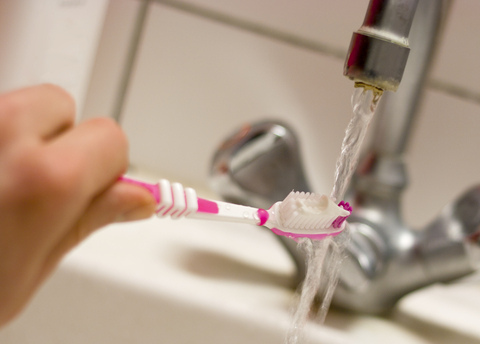October 20th, 2015

The fact is, according to the Oral Cancer Foundation, close to 40,000 Americans will be diagnosed with oral or pharyngeal cancer this year, resulting in more than 8,000 deaths. Men face twice the risk of developing oral cancer as women, and men who are over age 50 face the greatest risk. The American Cancer Society recommends an oral cancer screening exam every three years for people over the age of 20 and annually for those over age 40. The five-year survival rate is only 50 percent, and oral cancer, which is the sixth-most common diagnosed form of the disease, is one of the few cancers whose survival rate has not improved. Today, Dr. Cody Henriksen and our team would like to take this opportunity to remind all of our patients about the importance of maintaining good oral hygiene to prevent the disease.
So, what can you do at home to take an active role in preventing oral cancer?
The American Cancer Society recommends an oral cancer screening exam every three years for people over the age of 20 and annually for those over age 40. In addition, we encourage you to:
- Conduct a self-exam regularly. Using a bright light and a mirror, look at and feel your lips and gums. Try tilting your head back to look at and feel the roof of your mouth, and pull your cheeks out to look inside of your mouth, the lining of your cheeks, and your back gums. Pull out your tongue and look at all surfaces. Feel for lumps or enlarged lymph nodes in both sides of your neck and under your lower jaw. Please give us a call immediately if you notice any changes in the appearance of your mouth or any of the signs and symptoms mentioned above.
- Don’t smoke or use any tobacco products and drink alcohol in moderation.
- Eat a well-balanced diet. This includes eating a wide variety of foods from the five primary food groups on a daily basis to meet the recommended amounts of vitamins, minerals, carbohydrates, proteins, and fats you need in a given day.
- Limit your exposure to the sun. Repeated exposure increases the risk of cancer on the lips, especially the lower lip. When out in the sun, be sure to use UV-A/B-blocking sun protective lotions on your skin as well as your lips.
Please let us know if you have any questions about your oral health, either during your next scheduled visit, by giving us a call, or asking us on Facebook.
October 13th, 2015

You may have heard talk about the germs that can reside on your toothbrush and thought, “really?”
It’s true—there are several kinds of bacteria that can lurk on the bristles of your toothbrush, including streptococci, staphylococci, Herpes Simplex I, and the Influenza virus. To protect your toothbrush from bacteria, Dr. Cody Henriksen and our team want you to consider the following three tips:
- Wash your hands before and after brushing.
- Allow the brush to air dry after each use, as harmful bacteria dies after being exposed to oxygen. It is best to disinfect your toothbrush weekly and allow it to dry in between use. Store the toothbrush in an upright position to allow water to drain and dry faster
- Replace your toothbrush every three to four months, or after being ill. Worn bristles are less effective in properly cleaning your teeth, and can actually be damaging to teeth if used too long!
We hope these tips help! Feel free to give us a call at our Sioux Falls, SD office or ask us on Facebook if you have any questions!
October 6th, 2015

Dr. Cody Henriksen, as well as our team at Dental Comfort Center, would like to give those patients with flex spend, health savings, or insurance benefits a friendly end of the year reminder that it’s high time to schedule your dental visits so you optimize your benefit.
Now is the time to reserve your appointment with us. Space is limited and we tend to get busy around the holidays, so don’t wait to give us a call at our convenient Sioux Falls, SD office!
September 29th, 2015

Have you ever noticed your attention being instantly drawn to peoples’ teeth when they smile at you? Some people have dull and yellowing teeth, while others have teeth that appear bright white. Everyone’s teeth naturally dull over time because of aging and the contact your teeth have with staining foods, such as chocolate and coffee. However, teeth-whitening treatments can help you keep your teeth white for life.
Get Regular Treatments
The effects of teeth whitening or bleaching treatments are only temporary, so regular treatments at Dental Comfort Center are necessary to keep your teeth white for life. Bleaching too frequently, though, can wear away your tooth enamel. The effects of in-office bleaching can last for several months to a year, while you may need to repeat your use of at-home bleaching kits every few months to maintain your white teeth. Whitening toothpastes do not contain bleach, so you can use them daily. The American Dental Association suggests asking your dentist for advice on which treatment is best for you.
Have Realistic Expectations
Not everyone’s teeth can be turned bright white, according to the American Dental Association. Your teeth may naturally be a light yellowish color that lends itself well to teeth-whitening procedures, but bleach is not likely to be effective for grayish teeth. Brownish teeth fall somewhere in between.
Practice Good Oral Hygiene
Your teeth whitening efforts will not be as effective if your teeth are in poor health. Visible fillings, implants, or bridges that are metallic stand out against the white color you want to achieve. You can help prevent tooth decay and reduce your risk of needing these unsightly treatments by maintaining a good oral hygiene routine. In addition to brushing your teeth twice a day to remove dirt and potential staining agents, the actions below can promote a healthy mouth.
- Floss every day
- Visit Dental Comfort Center regularly
- Rinse your mouth with water after each meal and snack
- Limit sugary and starchy foods and beverages, especially between meals



